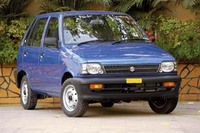Maruti 800 runs out of gas
 |
New Delhi,: The Maruti 800 — the tiny runabout that changed the face of motoring in India in the early eighties — will be withdrawn from Calcutta and 12 other cities from April.
Suzuki Motors of Japan, which has a 54.21 per cent stake in the Indian automaker, has decided to halt sales of the M-800 in these cities as it has no plans to upgrade the car’s engine to meet Euro IV emission standards that will become mandatory in all metros from April 1.
Some of the other cities are Delhi, Mumbai, Chennai, Bangalore, Hyderabad, Pune, Kanpur, Ahmedabad, Surat and Agra.
“I don’t think we have any plans to make the Maruti 800 BS-IV compliant,” Maruti Suzuki chairman R.C. Bhargava told reporters today on the sidelines of an industry conference.
Bharat Stage IV emission standards are equivalent to Euro IV standards. The Euro IV emission standards will be enforced across the country in 2015-16. So, the M-800 can continue to zip on Indian roads for another six years before it finally drives off into the sunset.
“When Euro IV is extended across the country, this model will have to be phased out as it would not be worthwhile to produce it,” Bhargava added.
Over the years, there have been intermittent bouts of speculation that the M-800 would be consigned to the scrap heap of history after Maruti Suzuki India launched the Alto in September 2000.
India’s biggest carmaker, however, kept the model in its line-up as it remained an enticing entry-level car for people who wanted to abandon their scooters and motorcycles and move up to a four-wheeler.
Over 2.7 million M-800s have been sold till date, making it the biggest-selling car in India’s automobile history. Next in the pecking order is the Alto which crossed the 1-million-mark in February 2008.
The Maruti 800, which attracted as much envy for its snazzy looks as derision from other car owners for its apparent vulnerability on Indian roads, soon became a big winner. People chose to wait for months to secure delivery rather than buy the staid Ambassadors and Fiats that seemed to be trapped in a time warp.
Launched as the first “people’s car, it whipped up a middle-class aspiration to own a car and the ultimate fascination was to ride in a bright red Maruti 800. More than anything else, it unleashed a riot of colour on Indian roads.
The car also introduced Indian drivers to the virtues of electronic ignition and synchromesh, floor shift gears that took out a lot of the pain and the agony of negotiating India’s pot-holed roads.
“There is a nostalgic value attached to it. If Maruti plans to auction its last car, then certainly, there would be collectors waiting to bid for it…there is always a fascination to own something unique and the M-800 would certainly fit that bill,” Dilip Chenoy, director general of the Society of Indian Automobile Manufacturers, told The Telegraph .
“People have already upgraded to the Alto or the Swift. Thus, it is not going to have a very major impact on the sales of these two vehicles which can continue in the rest of the country,” Bhargava added.
Sales of the M-800 have been faltering since 2004. In January, the carmaker sold just 2,494 units, down 55.2 per cent from 5,571 in the same month a year ago.
The carmaker, which introduced the concept of hatchbacks through the M-800, Alto, Wagon-R, Estilo, A-Star, Ritz and Swift, is now looking to reduce the number of vehicle platforms. This will mean phasing out some models that don’t meet emission standards.
At the same time, the company is looking to sharpen its edge by making the Alto, its most successful model, even more price efficient to compete in the small car segment which is expected to see a flurry of launches from Toyota, Honda, Volkswagen, Ford and Nissan. Top
Source: Indiacar.com Source : Telegraph.co.uk (2/12/2010)


